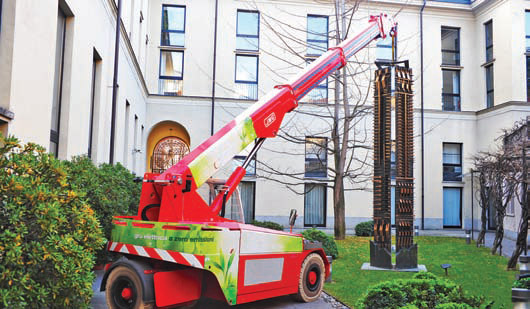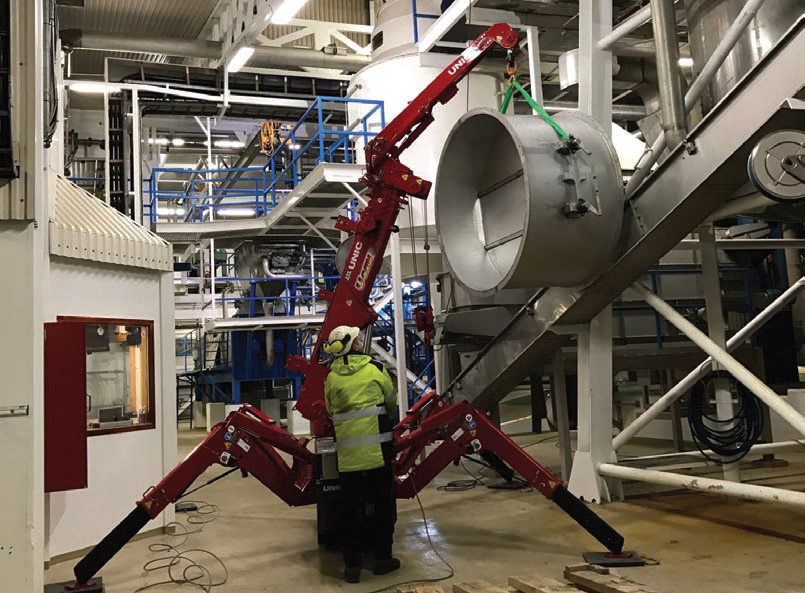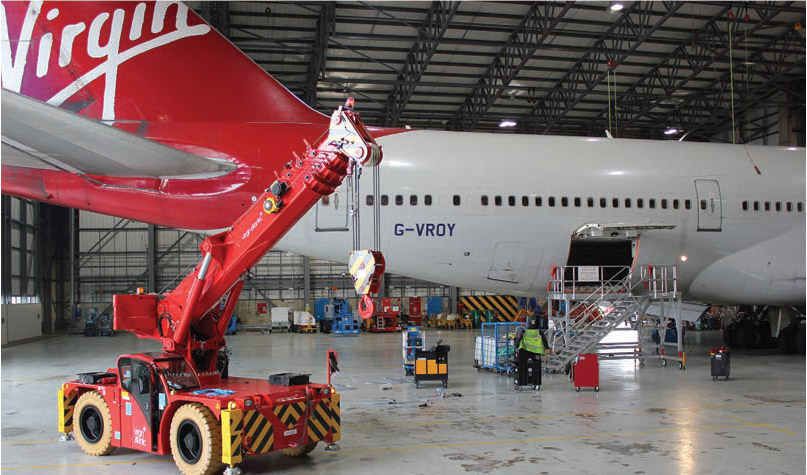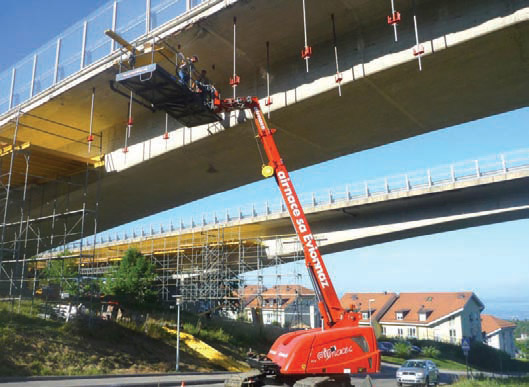Small and powerful
17 April 2017Minicranes and larger compact and pick-and-carry cranes are becoming popular all over the world, offering innovative solutions for work in confined spaces. Paola De Pascali reports
They can go where other machines can’t. They are small and light enough to travel through standard doorways or other tight areas. Minicranes may be mounted on wheels or on tracks, and powered by battery, diesel or even air from a remote pressure pump.
Japanese manufacturer UNIC has recently introduced the new 295-2, which is distributed in Europe by GGR Group. The main features include the Lift-Smart advanced safety system with a safe load indicator to prevent the crane operating outside of its safe working envelope. Offering a lifting capacity of 2.9t, the same as the standard URW 295 model, the introduction of the new hydraulic extension jib on the URW 295-2 increases the lifting height up to 11.7m. The UNIC URW-295 can be used for several applications, from construction work and plant maintenance to steel erection, cladding installation and railway maintenance.
In a recent application, this minicrane was used to lift ducting into place for a GGR client in Iceland. Minicranes can be alternatively described as ‘spider cranes’ for the way they look with their jointed outriggers extended.
A UNIC URW 094 spider crane and a GGR 600 plus vacuum lifter were used to lift and place glass on to a brand new staircase at the Barbican Centre in London.
By relying on Unic spidercrane power and GGR patented glass-sucker technology, the glass staircase was precisely assembled for the grand opening.
The main role of the spider crane and vacuum lifter was to carefully manoeuvre the glass from the glass trolleys and place it into position for the staircase to be assembled. Each piece of glass weighed up to 240kg, but the mini spider crane was easily able to lift and move the glass into place, with an extra helping hand from GGR’s 600 plus vacuum lifter.
The project took place in a confined space, where glass had to be lowered from the first floor to the ground floor below, but the compact UNIC 094 spider crane was able to manoeuvre the glass to its desired location.
This product features a 300– 600kg safe working load and 360° lockable rotation. The glazing sucker installation ring can easily clear the narrow space between a facade and scaffolding, yet still allow glass panels to be rotated into position for accurate installation.
The UNIC URW 094 spider crane delivers unparalleled lifting capacity for its size, capable of handling loads up to 995kg. The 5.5m long boom offers a maximum hook height of 5.6m.
Another example is the UNIC URW-706 spider crane, which worked on Crossrail’s Canary Wharf station project. This spider crane was employed to install three 1.3t ventilation units to allow hot air to escape from the rail tunnels below when the 120km-long line from Heathrow Airport to central London is up and running.
Working at a 13m maximum lifting height, the Unic URW-706 lifted and installed the £75,000 stainless-steel louvre units in six halves.
Operated by one of GGR’s operators, the minicrane had to lift with accuracy underneath the building’s deep overhang and hold the units at a 54° angle so they could be fixed into position. The spider crane on the Crossrail project was positioned on a temporary platform on the dockland waters to get access to the lifting location.
“We continuously listen to feedback from our customers and dealer network to ensure that their specific needs are met and any product development can reflect the needs of the market place,” says GGR Group CEO Graeme Riley. “Examples of this include the development of battery-powered, zero-emission eco-cranes, which have the same lifting capacity as our standard IC engine cranes. Also, one of our newest developments, the hydraulic extension jib on our 706-2 model, increases the lifting height to 26m, giving our customers more options to help meet their bespoke lifting requirements.”
Maeda has recently expanded its range with the MK 1033CW-1, equipped with a knuckleboom.
“The addition of this new crane enables Kranlyft and Maeda to become an even greater force in the growing glass-handling market, petrochemical industry and many other projects where the use of a hydraulic jib is required, such as maintenance inside factories,” says Alan Peck, sales director at Kranlyft UK, the distributor for Maeda minicranes.
The new crane is a narrowaisle, operator-controlled crane like the rest of the MC range, but with the advantage of a hydraulic six-section luffing boom and jib.
This gives the crane a relevant ‘up-and- over’ capacity, making it easier to perform many tasks, such as installing glass in windows frames, lifting over pipes in narrow spaces and placing dormers and Velux units on top of roofs.
The MK1033CW-1 is still slim enough to fit through a standard doorway, being 75cm wide and less than 2m high. The overall length is 2.73m and it weighs 2.09kg in order to fit in construction elevators. The small knuckle boom has a maximum capacity of 0.995t, with a maximum working height of 1.3m and a maximum working radius of 9.9m.
The basic model has a diesel engine and comes with a fixed crane hook on the end of the boom to reduce the distance between the top of the boom and the hook. Each outrigger can be placed in seven different horizontal positions and six different outrigger length positions.
Maeda designed this minicrane according to safety standards, including a device that stops the boom movements automatically before coming into any restricted areas. This allows two outriggers to be positioned fully stretched alongside a wall, still having the maximum capacity on the opposite side of the crane.
The MK1033CW-1 is also equipped with a new ‘read-out’ display, showing not only outrigger and boom positions, but also additional service information and a quick operation guide.
Amongst the newest models are the CC1485 and the MC815. The CC1485 offers a lifting capacity of 6t, a boom length of 16.7m, a rear-view camera and 7in monitor as standard. It is designed without outriggers, which means an extremely slim working footprint.
This environmentally friendly machine is equipped with an EU Stage 3B-compliant engine, making it up to 40% more fuel-efficient.
The new fly jib attachment sees a move towards a more traditional wraparound system, which is much more user-friendly and easier to operate.
Other features include a fully enclosed air-conditioned cab with link slide door, minimal tail swing, powerful two-speed high and low winch, hydrostatic transmission, hydraulic disc brake and automatic heptagonal five-section boom.
The MC815 model has a 8t lifting capacity with a 19.4m tipping height, a new 10.4in multi-function touchscreen monitor and the added bonus of 1,000kg pick-and-carry capacity. The optional 1,500kg safeworking- limit hydraulic two-section fly jib increases maximum lifting height to 25.5m. There is an all-new searcher hook, giving class-leading duties of 1t.
New to this model is the powerlifting mode, joystick control, new Technos 2 radio-telemetry system with joystick control, auto-levelling via remote, auto-crane-stow via remote, Maeda Safety Operation System (MSOS) and EU stage 3B-compliant engine to make it environmentally friendly.
Among the Maeda minicranes’ recent applications, the MC405 spent a cold winter’s day unloading goods at the Guernsey port of Herm. The 60t bags of aggregate were taken off an inter-island freight boat. Maeda’s Polish distributor, Mini Zurawie Pawel Michalczewski, also hired out two Maeda MC405 cranes to lift and place a 6t stone altar, getting inside the church through a small door.
Maeda’s rental division sent two MC285C cranes to a super-strong paper contest. A Japanese TV channel recently re-ran an episode of Supreme Skills! in which contestants raced to build super-strong paper cartons. The challenge was to make a box that could withstand 1tm of weight, using just 800g of paper.
A manufacturer of cardboard boxes vied with a paperboard box specialist with 45 years of experience.
A glass and curtain wall company also used the Maeda MC285-2 to hoist and install unitised glass curtain-wall panels on the exterior of Amegy Bank’s new Houston headquarters in Texas.
The contractor had been using conventional equipment, which would hoist one panel from the floors below and then set them into place, move the equipment, then set another panel. However, panels on the facade of the parking-garage structure were larger and heavier than could be safely handled with the smaller-capacity equipment, and the installation area could not be reached by the existing tower crane onsite. With the MC285 set up in one position, up to six panels could be set in sequence without a machine move.
When the next section of panels was installed, repositioning the MC285 could be done in minutes.
The MC285’s moment limiter safety system – with programmed load charts combined with Maeda’s outrigger interlock safety system – made hoisting the panels of various weights from floors below safe and efficient for the operator.
“The MC285 excels on job sites where the tower crane can’t reach, or is busy doing other tasks for various contractors,” Peck says. “On this project, the tower crane could not reach the areas where the curtain wall was being installed, so the MC285 was called in to handle the task.”
Italian manufacturer Jekko recently introduced the telecrawler SPK60, which has been ANSI tested and certified, to the US market. The SPK60 is a 6t telecrawler crane with main boom and telescopic hydraulic jib; it weighs 12.5t with counterweight in place. It has a maximum capacity free on tracks of 6t, a 17.7m five-section main boom, plus a four-section telescopic hydraulic jib for a maximum tip height of 27m. Maximum radius with the jib is 12m, while it can luff from being almost in line to with the boom, down to horizontal. The operator cab is standard equipment and the unit is powered by a Yanmar diesel engine.
Rich Caudill, product manager and minicrane specialist at Jekko USA, says: “The new Jekko SPK60 provides a safer way to move pipe, pre-cast concrete barriers, steel, re-bar and other heavy material on and around a construction site.”
Jekko USA CEO Bernie Faloney adds: “If other crane manufacturers are launching big telescopic crawler cranes (TCC), we are excited to introduce the SPK60, which is easier to transport and operate in confined spaces where big cranes can’t go.
“Minicranes can be transported on a trailer instead of a TCC crane, which could take four or five trucks. In addition, when a machine is light, it doesn’t require special permits to travel on highways.
“I’m happy about the potential market because I am sure that when people visualise the real jobs that minicranes can do, they will want to have this crane in their fleet.”
Minicrane applications include glass handling, water treatment plants and other utilities, oil and gas refineries, general construction, restoration and more. “A good example of a Jekko project happened at Haverford College near Philadelphia, Pennsylvania,” Faloney explains. “The contractor turned to a Jekko SPX 1275 to help reinforce interior walls of a campus chapel. The crane was small and tightly controlled enough to operate inside the chapel without damaging the more-than-100-year-old structure, yet strong enough to lift and secure hundreds of pounds of reinforcing steel.”
Minicranes are also being used to install solar panels. “Solar panels are placed in rows and installation requires precision and control,” says Faloney. “You need equipment that can navigate along the rows and install these delicate, intricate panels on their stands. This makes minicranes, and their ability to be operated via remote control, perfect for these kinds of jobs.”
Faloney notes that Jekkos have also been used regularly in movies. “Jekkos were used in parts of the aerial choreography in The Amazing Spiderman 2, and two Jekko SPD 360s even appeared in a substantial scene in Transformers 4.”
Another new model is the SPX429, which is similar to SPX424 but with a longer boom version.
“It’s made only for the US market and it’s not offered anywhere else,” Faloney says. “Jekko USA required a machine with more strength and resilience to provide more reliability,” adds Mauro Tonon, sales and marketing manager at Jekko. Other Jekko applications include the $30-million upgrade on The Statue of Liberty National Monument to allow better safety and security while maintaining the historic look and finish of the monument.
The project involved the addition of two new staircases, renovation of a third staircase, removal and reinstallation of 3,400ft² (315m²) of granite pavers and wall panels, and the overall manipulation of approximately 85t of stone. The project’s stone subcontractor recognised that it needed a very specialised piece of equipment that could lift, hold and manoeuvre the pavers and slabs – each of which weighed between 300lb (136kg) and 1,000lb (453kg) – but still work in a confined area at the base of Lady Liberty. The contractor put at work the Jekko SPD360 for its ability to stabilise itself to work in areas where not all four of its outriggers could have the best footing. Just one person was enough to manage the manoeuvring while other technicians helped secure the stone in place.
Pittsburgh Glass Works (PGW) used a Jekko SPD 360 to install a circulation fan just a few months ago at its fabrication facility in Elkin, North Carolina.
PGW used the Jekko to lift a 810lb (367kg), 60in (1.5m) fan and base to a height of 26ft (7.9m). PGW selected the crane because its nonmarking white treads and exhaust-free electrical operations made it perfect for interior use without disrupting the environment inside the facility.
Cranes and access sales and rental specialists TCA Lifting have sold a Jekko SPX1275 spider crane to easyJet, Europe’s leading shorthaul airline, for the maintenance of its Airbus fleet. When replacing their existing Jones IF10, easyJet wanted a more modern, environmentally friendly crane with improved lifting capabilities.
The SPX1275 offers 7.5t outriggers and 2t pick-and-carry, dual power (diesel and 380V AC) and 26m lift height. “During the trial of the crane, its user-friendly remote controls were ideal for allowing the operator to be perfectly positioned when lifting alongside the aircraft,” says TCA Lifting co-owner Phil Lomax.
The SPX1275 will be used for lifting several aircraft components with weights of up to 7t and lift heights of over 20m using the optional lattice jib. The SPX1275 benefits from a small outrigger footprint and class-leading pick-and-carry duties, allowing more flexibility during lifting operations.
Other Jekko applications in Europe include a maintenance service at a Switzerland stadium for the installation of the gallery seats.
“The job was carried out by our Swiss dealer Arbor with a Jekko SPX312, which worked at height, where low ground pressure is required, together with a great manoeuvrability of the crane,” says Tonon.
Pick and carry
A pick and carry is a mobile crane without outriggers designed to lift and move a specific load to the destination.
Caudill highlights the range of jobs performed by these cranes; he says: “Some recent jobs include wastewater treatment and paper-towel plants like Kimberly-Clark. Minicranes can operate safely in an interior environment, and are strong enough to extract pumps and fans that can weigh hundreds or thousands of pounds.
“Small cranes are also used to remove emulsifying units, which churn up solid materials in drainage and sewer lines in municipalities for inspection and maintenance.
These machines can weigh hundreds of pounds, and must be extracted from underground out of narrow passages. US minicrane users are finding compact cranes ideal for interior work and sensitive even in dangerous areas.
“Because of their electric capability, precise movements and technological advantages, and also because they can be operated quietly, without fumes or leaking fuels, and with non-marking tires, these cranes can be used anywhere, from a nuclear energy facility to a cathedral,” adds Caudill.
Valla Cranes, the recently acquired Italian-based industrial crane division of US lifting business Manitex, offers pick-and-carry cranes to be used in several applications such as machinery moving, factory maintenance, artwork installation, structure management and manufacturing.
Virgin Atlantic Airways acquired the 22t Valla 1725 48ES DC electric minicrane for aircraft maintenance at Gatwick Airport.
Virgin Atlantic planned in 2016 to work with its aviation suppliers to obtain approval to use the pick and carry to change engines on its aircraft.
Aviation ground-support equipment specialist Rushlift approached minicrane hire and sales specialist Hird to supply the crane, as part of its equipment supply and maintenance service for Virgin Atlantic.
Andy Currey, tooling and ground support equipment manager at Virgin Atlantic, said: “We will be leading the way in what I believe in five years’ time will be an industry standard for changing engines.
“Our engineers are really happy with the Valla minicrane. It’s easy to use, it’s a precision tool, it’s quiet, and it’s non-polluting. It also has all the latest COBO 3B6 digital load control systems, so we know precisely what weight we’re lifting and how it needs to be managed safely.”
Currey adds: “The minicrane has capabilities unique to Virgin Atlantic’s needs. Its boom can slew through 360° continuous, it has a maximum lifting capacity of 22t, a working height of 15.5m, and a reach of 13.5m. The minicrane has fully blocked and short blocked duties in free-on-wheels and pick-and-carry modes.”
One of the UK’s biggest oil-refining and fuels companies, Essar, took delivery of the largest Valla pick and carry for a wide range of maintenance tasks, including replacing valves, installing new pipework, and repair of fluid and air pumps.
Hird supplied a new Manitex Valla 90D pick and carry for use at its giant Stanlow Refinery Ellesmere Port in Cheshire.
Hird sales and aftersales manager Carl Cooper says: “We are delighted to continue to support Essar with their lifting requirements.
The quality and durability of Valla minicranes are key factors in their success at the Stanlow Refinery site. “As oil refining and fuel production are continuous production processes, companies like Essar need to be sure of the reliability of their maintenance equipment, and Valla pick-and-carry cranes deliver on that score.”
The new Valla 90D industrial minicrane has a maximum safe working limit of 9t. It has a maximum tip height of 8m, at which point it can lift 2.8t.
The diesel-powered pick and carry is designed specifically for operating in industrial environments and for lifting in confined spaces. This is supported by power steering operated through a telescopic hydraulic ram fitted between the articulated steering unit and the crane frame.
This allows 140° steering. The Valla 90D pick-and-carry crane is fitted with a COBO 3B6 digital load-monitoring system as standard to support optimum safe lifting performance.
“We recently supplied a Valla 1725 36 D to the Boliden Group working at TARA Mines in Ireland,” Cooper says. “The 16t Valla crane is replacing an old crane on site, working in the main part of the production plant. The duties of the crane include 360° degree continuous slewing, free on wheels and pick and carry.”
Italian-based company Ormig is manufacturing pick-and-carry cranes for lifting and load moving in outside yards. “We also manufacture electric pick-and-carry cranes for loads lifting, and handling indoor and industrial activities, in compliance with environmental and acoustic anti-pollution regulations,” says Gian Paolo Aschero, marketing director at Ormig. “Our product range includes pick-and-carry cranes of 5.4–60.0tm, and we offer other equipment to be mounted on to the tip of the jib, such as hydraulic jibs, pincers, forks and special hooks.
Our recent applications include lifting with a mechanic jib in a plastic factory in Sassuolo, Italy; a 5.5tm pick and carry with a hydraulic jib was employed for the assembly of packaging machines; assembly of overhead travelling crane and beam through a hydraulic jib in positive angle 45°; and a 5.5tm pick-and-carry crane used for petrochemical plant maintenance.”
Another Italian pick-and-carry brand is JMG Cranes, which was founded by Maurizio Manzini in 2007. “My 30-year experience in this sector helped me to set up this company, choosing the best components on the market,” says CEO Manzini.
“In 2015, we decided to acquire the Lige brand, which includes batteryoperated pick-and-carry cranes and more than 70 years of experience. In 2016, JMG started to renew the range of Lige electric pick-and-carry cranes, introducing new models.
“In 2017, JMG launched a new electric pick and carry, the JMG MC580, which can lift and transport up to 58t.”
The MC580 can provide four removable counterweights for transport and hydraulic boom extensions of the axle to increase the lifting capacity in several configurations.
This electric pick and carry is equipped with a cabin, a 7in colour display compliant with EC standards, a hydraulic telescopic boom with proportional output and radio remote control.
“JMG Cranes provides battery-operated electric pick-and-carry cranes all over the world, ensuring assistance and aftersales service,” Manzini says.
These pick-and-carry cranes can be used in several sectors such as aerospace, food industry, automotive, glass industry, producers and users of coils, and maintenance and handling of printing machinery.
“The 4.5t MC 45 is used to handle aircraft engines in the assembly and maintenance facility of an aerospace company. Thanks to its flexibility, this pick and carry can move heavy loads even in confined spaces.
“JMG’s product line also includes the MC 250 and MC350, which have been employed in the handling of carpentry machinery. These pick-and-carry cranes of 16 and 35t can ensure efficiency and safety thanks to their compactness and precision. Another relevant sector is the museum industry because JMG pick-and-carry cranes provide a very small footprint, ensuring the maximum performance even in very narrow areas with low ceilings.
Thanks to the steering radius, these pick-and-carry cranes are able to move artworks carefully.”
For example, the JMG MC85 installed a big bronze structure by Italian artist Arnaldo Pomodoro. The MC85 carried out the job thanks to its simultaneous movements, electro-proportional distributor and non-marking tires. The fragility of the sculpture and the marble floors presented the primary challenge.
The MC 85 was able to overcome narrow hallways in a short time thanks to the steering axle at 180° and the absence of outriggers. The statue was installed without any accidents.
JMG Cranes will soon introduce to the market the new electric radio remote controlled 13t MC 130 S. The official presentation will take place at the manufacturer's Sarmato facility, on the 19th and 20th of May, on the occasion of the Open House event.
Alternative solutions
Italian-based manufacturer of aerial platforms Palazzani designed and launched the hydraulic wire-winch to make aerial platforms work as minicranes.
“These machines are not designed as minicranes, but by disassembling the basket and attaching this hydraulic wire-winch with a lifting capacity of 500kg, they can carry out crane jobs,” says Aldo Arcari, a Palazzani engineer. “The hydraulic wire-winch is composed of several components, such as a hydraulic motor, the certified rope of 7mm diameter and a length of 25–46m, a certificate hook with 800kg capacity, and a wireless control for the rope lifting and lowering. This solution was used for the first time on the Ragno TSJ 25/C, and after getting good feedback, the company decided to attach it on all models of aerial platforms, including crawler and wheel versions in the height range between 25 and 52m.”
The Palazzani XTJ43/C operated in Shepherds Market in the heart of Mayfair in London for the development of three-storey townhouse with roof terraces. The XTJ43 was used to lift skylights into position but was also used to lift other materials including steel, scaffold poles on to the roof area. The main request was a crane that could fit in a very congested and space-restricted area, with low floor loading and lift loads at 38m high and 9m radius.
“The Palazzani have introduced crane options across their complete spider range, and we think the easily interchangeable crane and access attachments will prove popular with utilities companies and end-users for building maintenance. They are an excellent solution for architects trying to meet their CDM obligations,” says TCA Lifting, Palazzani’s UK dealer.
“The XTJ43 has also been very successful as a conventional spider boom with its telescopic fly jib, 330kg SWL, below horizontal capability and compact dimensions at the Westferry Circus, Canary Wharf.”
Germany-based company Giraf Crane offers a type of pick and carry called Giraf Track, a polyvalent grounding machine on caterpillars with interchangeable attachments. Giraf Track was originally developed in Belgium by Testcentrum De Lille.
The Giraf Track works like a mobile telescopic crane, and has a telescopic boom with a hook and winch. It can lift any item up to 8t when it is stationary. As the machine has a crawler, it doesn’t have tyres so it can pick up to 6t and carry it to the desired place. So any cargo can be transported on this crawler device even at inclined ground like a caterpillar. “An easy handling, even of bulky or protruding goods, is also possible when the item is suspended, unlike when you are operating a telescopic forklift,” says Piotr Chartowski, responsible for quality management at Jaromin, sister company of Giraf Crane.
The Giraf Track GT580 is a special crawler crane with a cabin available on request. Features include a height of 2.6m, rubber pads, remote control, optional 5m jib, electric drive 380V 32A and 30m cable.
“I believe the real innovation is that these machines can pick and carry,” Chartowski says. “Most devices provide telescopic forklifts, but the maximum lifting capacity is 3t and they are wheel-driven. Even though telescopic forklifts can be a bit faster with a speed of 20km an hour – our Giraf Crane can do 6km an hour – it can pick and carry up to 6t with very high extension. This means that the load can be very long and spacious and it can be positioned everywhere on the construction site. We can drive it around the building and assemble it wherever we want. Conversely, forklifts can only work on plain ground, otherwise they would slip.
“Our experience shows that in many cases, it is equivalent to a mobile telescopic crane of 30t-capacity class, only more handy.”
Some recent applications include inspection of solar panels on a rooftop and the assembly of a steel construction for a clock on a marketplace. “A Giraf crane has been also used during a bridge construction, showing its high stand of about 6–8m. It offers not only the pick-and-carry function, but also assembly for steel construction,” Chartowski says. “When we have steel elements or building bricks, we can pick these elements from the truck with a heavy cargo and transport them to the construction site.”
This article has been amended online to correct an error.
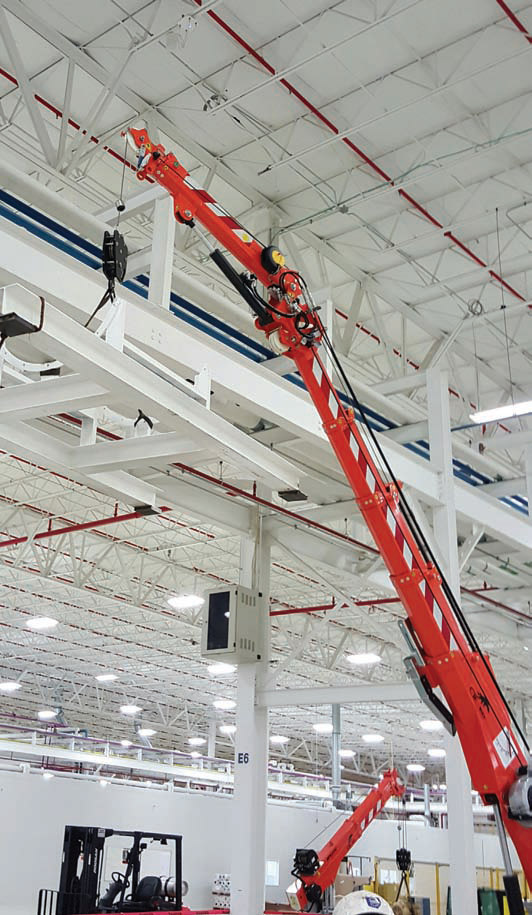 Pittsburgh Glass Works used a Jekko SPD 360 to install a circulation fan just at its fabrication facility in Elkin, North Carolina.
Pittsburgh Glass Works used a Jekko SPD 360 to install a circulation fan just at its fabrication facility in Elkin, North Carolina.
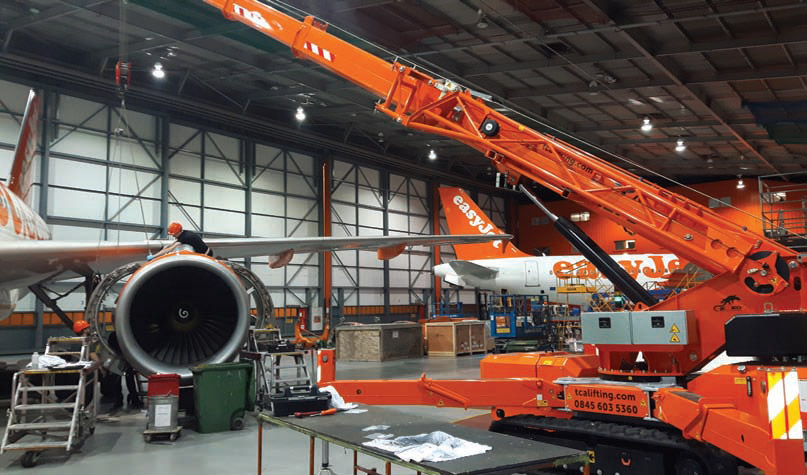 Cranes and access sales and rental specialists TCA Lifting have sold a Jekko SPX1275 spider crane to easyJet for the maintenance of their Airbus fleet.
Cranes and access sales and rental specialists TCA Lifting have sold a Jekko SPX1275 spider crane to easyJet for the maintenance of their Airbus fleet.
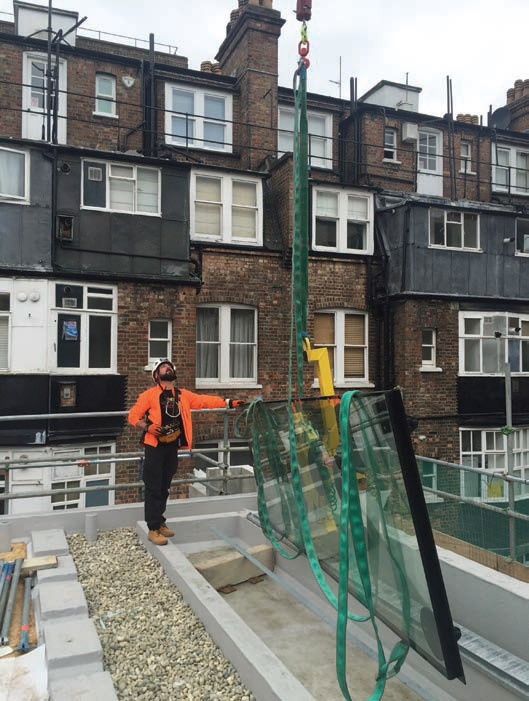 The Palazzani XTJ43/C at work in the heart of Mayfair in London for the development of three-storey townhouse with roof terraces
The Palazzani XTJ43/C at work in the heart of Mayfair in London for the development of three-storey townhouse with roof terraces
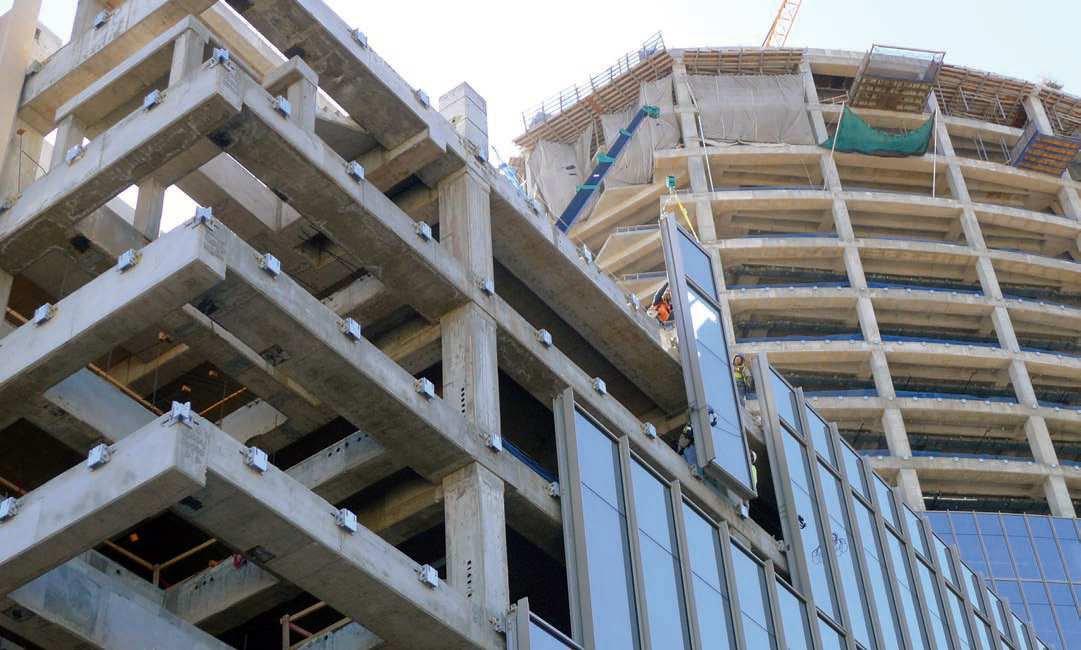 The Maeda MC285-2 minicrane was used to hoist and install unitised glass curtain wall panels on the exterior of Amegy Bank’s new Houston headquarters in Texas.
The Maeda MC285-2 minicrane was used to hoist and install unitised glass curtain wall panels on the exterior of Amegy Bank’s new Houston headquarters in Texas.
